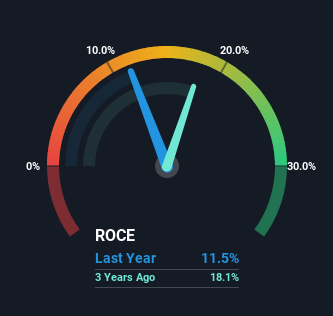- China
- /
- Semiconductors
- /
- SHSE:603290
Here's What's Concerning About StarPower Semiconductor's (SHSE:603290) Returns On Capital

To find a multi-bagger stock, what are the underlying trends we should look for in a business? Typically, we'll want to notice a trend of growing return on capital employed (ROCE) and alongside that, an expanding base of capital employed. Ultimately, this demonstrates that it's a business that is reinvesting profits at increasing rates of return. Having said that, from a first glance at StarPower Semiconductor (SHSE:603290) we aren't jumping out of our chairs at how returns are trending, but let's have a deeper look.
Return On Capital Employed (ROCE): What Is It?
Just to clarify if you're unsure, ROCE is a metric for evaluating how much pre-tax income (in percentage terms) a company earns on the capital invested in its business. To calculate this metric for StarPower Semiconductor, this is the formula:
Return on Capital Employed = Earnings Before Interest and Tax (EBIT) ÷ (Total Assets - Current Liabilities)
0.12 = CN¥926m ÷ (CN¥8.8b - CN¥784m) (Based on the trailing twelve months to March 2024).
So, StarPower Semiconductor has an ROCE of 12%. On its own, that's a standard return, however it's much better than the 3.9% generated by the Semiconductor industry.
Check out our latest analysis for StarPower Semiconductor

Above you can see how the current ROCE for StarPower Semiconductor compares to its prior returns on capital, but there's only so much you can tell from the past. If you'd like, you can check out the forecasts from the analysts covering StarPower Semiconductor for free.
What The Trend Of ROCE Can Tell Us
On the surface, the trend of ROCE at StarPower Semiconductor doesn't inspire confidence. Over the last five years, returns on capital have decreased to 12% from 19% five years ago. Although, given both revenue and the amount of assets employed in the business have increased, it could suggest the company is investing in growth, and the extra capital has led to a short-term reduction in ROCE. If these investments prove successful, this can bode very well for long term stock performance.
On a side note, StarPower Semiconductor has done well to pay down its current liabilities to 8.9% of total assets. That could partly explain why the ROCE has dropped. What's more, this can reduce some aspects of risk to the business because now the company's suppliers or short-term creditors are funding less of its operations. Since the business is basically funding more of its operations with it's own money, you could argue this has made the business less efficient at generating ROCE.
The Key Takeaway
Even though returns on capital have fallen in the short term, we find it promising that revenue and capital employed have both increased for StarPower Semiconductor. And there could be an opportunity here if other metrics look good too, because the stock has declined 48% in the last three years. So we think it'd be worthwhile to look further into this stock given the trends look encouraging.
On a final note, we found 2 warning signs for StarPower Semiconductor (1 is concerning) you should be aware of.
While StarPower Semiconductor isn't earning the highest return, check out this free list of companies that are earning high returns on equity with solid balance sheets.
New: Manage All Your Stock Portfolios in One Place
We've created the ultimate portfolio companion for stock investors, and it's free.
• Connect an unlimited number of Portfolios and see your total in one currency
• Be alerted to new Warning Signs or Risks via email or mobile
• Track the Fair Value of your stocks
Have feedback on this article? Concerned about the content? Get in touch with us directly. Alternatively, email editorial-team (at) simplywallst.com.
This article by Simply Wall St is general in nature. We provide commentary based on historical data and analyst forecasts only using an unbiased methodology and our articles are not intended to be financial advice. It does not constitute a recommendation to buy or sell any stock, and does not take account of your objectives, or your financial situation. We aim to bring you long-term focused analysis driven by fundamental data. Note that our analysis may not factor in the latest price-sensitive company announcements or qualitative material. Simply Wall St has no position in any stocks mentioned.
About SHSE:603290
StarPower Semiconductor
Researches, designs, develops, produces, and sells power semiconductor components worldwide.
Excellent balance sheet with moderate growth potential.
Market Insights
Community Narratives



